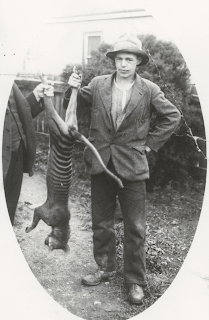PRESENTED BY
THE DOMESDAY BOOK OF DOGS
De-extinction of the Thylacine
Thylacine killed by Clem Penny.
Courtesy of Libraries Tasmania, 1920.
PH30/1/6303
National Library of Australia.
The thylacine (Thylacinus
cynocephalus) was first sighted and recorded by European colonists in 1805, the
last known specimen died in captivity in 1936.
It took just one hundred and thirty-one years to completely wipe out the
world’s largest extant marsupial carnivore (about the size of a medium-sized
dog). The extermination was conducted on
an industrial scale with seemingly wanton cruelty and even as the species was
becoming scarce the killing carried on thanks to a government bounty
scheme. The thylacine ate only small animals,
there is even an account of an individual catching tadpoles (Paddle, 2000),
yet Tasmanian’s referred to it simply as ‘the tiger’, ‘the wolf’ or ‘the hyena’
and blamed it for ravaging the sheep population when feral dogs of near plague proportions
were the most likely culprits. The last
authenticated death of a thylacine in the wild occurred on 6th May
1930.
Life was tough for
the majority of Tasmania’s settlers who were for the most part callous and
largely unschooled, maybe they knew no better, but it’s the scientists of the
day who deserve all the opprobrium we can muster. They were helpless in the face of the
slaughter, and sometimes even indifferent to the plight of the thylacine. Myths of vampirism concocted as an excuse for
the carnage were seized upon and, in the early twentieth century, actually
entered into scientific construction. Perhaps
worse, healthy potential breeding stock were taken from the island and placed
in ‘solitary confinement’ in zoos around the world. Any attempts at breeding were at best haphazard
and cack-handed and at worst inept or even negligent and suffered, in many
cases, from a distinct lack of finance, space or common-sense.
Of later years the remorse and sense of loss
are palpable. Since 1936 there have been hundreds of ‘sightings’ both in
Tasmania, and mainland Australia where, it’s believed, the species became
extinct over 3,000 years ago. Sadly, any
photos tend to be blurry, even suspicious.
Nowadays there is a growing body of scientists who believe that cloning
would be feasible. Professor Mike Archer
first proposed cloning thylacines in the 1990s and the technology has come on
by leaps and bounds in the intervening years.
In 2009 Penn State University successfully sequenced the mitochondrial
DNA of two individuals: where once it was thought that the DNA would be too
badly degraded researchers have discovered that it is much more viable when extracted
from hair or teeth. An alternative to
cloning, CRISPR-Cas9, allows easy, cheap DNA editing and this could be a route
towards recreating the thylacine, possibly using genetic material from the quoll
or numbat as a foundation. This most
unique, distinctive and fascinating species (effectively a marsupial dog), pitilessly
wiped out by humans, may yet return.
 |
| Thylacine. Renshaw, 1905 |
--- Explore further ---
London. Sherratt & Hughes. 1905
Amy Spurling. E&T. 2018.


Comments
Post a Comment